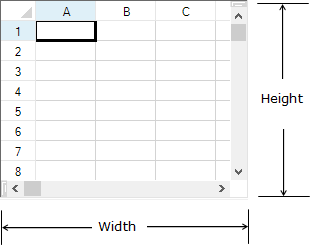-
Spread Windows Forms Product Documentation
- Getting Started
-
Developer's Guide
- Understanding the Product
- Working with the Component
- Spreadsheet Objects
- Ribbon Control
- Sheets
- Rows and Columns
- Headers
- Cells
- Cell Types
- Data Binding
-
Customizing the Sheet Appearance
- Customizing the Dimensions of the Component
- Customizing the Individual Sheet Appearance
- Customizing the Appearance of a Cell
- Customizing the Overall Component Appearance
- Creating and Applying a Style for Cells
- Using Conditional Formatting of Cells
- Customizing the Display of the Pointer
- Customizing the User Interface Images
- Using XP Themes with the Component
- Customizing the Renderers
- Handling Right-to-Left Layouts
- Customizing Painting of Parts of the Component
- Text Rendering with GDI
- Applying Theme to Customize the Appearance
- Customizing Interaction in Cells
- Tables
- Understanding the Underlying Models
- Customizing Row or Column Interaction
- Formulas in Cells
- Sparklines
- Keyboard Interaction
- Events from User Actions
- File Operations
- Storing Excel Summary and View
- Printing
- Chart Control
- Customizing Drawing
- Touch Support with the Component
- Spread Designer Guide
- Assembly Reference
- Import and Export Reference
- Version Comparison Reference
Customizing the Dimensions of the Component
You can set the overall dimensions of the Spread component and this determines the size of the visible area of the spreadsheet. The following figure shows the dimensions that you can set by setting the number of pixels for each.

Refer to the Microsoft .NET Framework documentation for more details on the Control.Height property or Control.Width property.
To calculate the height of the Spread, assuming scroll bars turned off and no headers, calculate the height of all the rows and then add one pixel for every border, so if 10 rows of 20 pixel height, (10 x 20) + (10 x 1) + 1, or 211 in this example. For the Spread width, the process is the same. For more information on setting the row height and column width, refer to Setting the Row Height or Column Width.
Using the Properties Window
Select the Spread component.
With the properties window open, in the Layout category, select the Height property or the Width property and type in a new value. The unit is pixels. Press Enter. The new dimension is now set.
Refer to the Microsoft.NET Framework documentation for setting the units of measurement for height to something other than the default, which is pixels.
Using Code
Add a line of code that sets the specific dimension. Unless you have set it otherwise, the default for the unit of measurement is pixels. Use the Height and Width properties of the FpSpread class.
Example
This example shows how to set the height of the Spread component to 250 pixels and the width to 300.
fpSpread1.Height = 250;
fpSpread1.Width = 300;fpSpread1.Height = 250
fpSpread1.Width = 300See Also
Customizing the Sheet Appearance
Customizing the Individual Sheet Appearance
Customizing the Appearance of a Cell
Customizing the Overall Component Appearance
Creating and Applying a Style for Cells
Using Conditional Formatting of Cells
Customizing the Display of the Pointer
Customizing the User Interface Images
Using XP Themes with the Component
Handling Right-to-Left Layouts


